Introduction to Gyudon Japanese Beef Rice Bowls
Why Gyudon is the Perfect Comfort Food
If you’re searching for a meal that embodies warmth and comfort, look no further than Gyudon Japanese Beef Rice Bowls. This delightful dish features succulent, thinly sliced beef simmered in a slightly sweet sauce made with mirin and soy sauce, served over a fluffy mound of rice. With its beautifully tender meat and aromatic flavors, Gyudon is more than just food; it’s a hug in a bowl.
Imagine coming home after a long day, greeted by the inviting scents of beef and onions wafting from your kitchen. As you dig into your bowl, the combination of rich flavors and the soft, runny yolk from the egg on top creates an explosion of comfort that’s simply unmatched.
Plus, Gyudon’s simplicity makes it a go-to weeknight meal that can be prepared in just 40 minutes. According to the Japanese Culinary Academy, this dish is beloved not only for its taste but also for its ability to bring families together around the table.
Whether you’re a seasoned cook or a beginner, making Gyudon at home is an effortless way to indulge in a beloved Japanese classic.
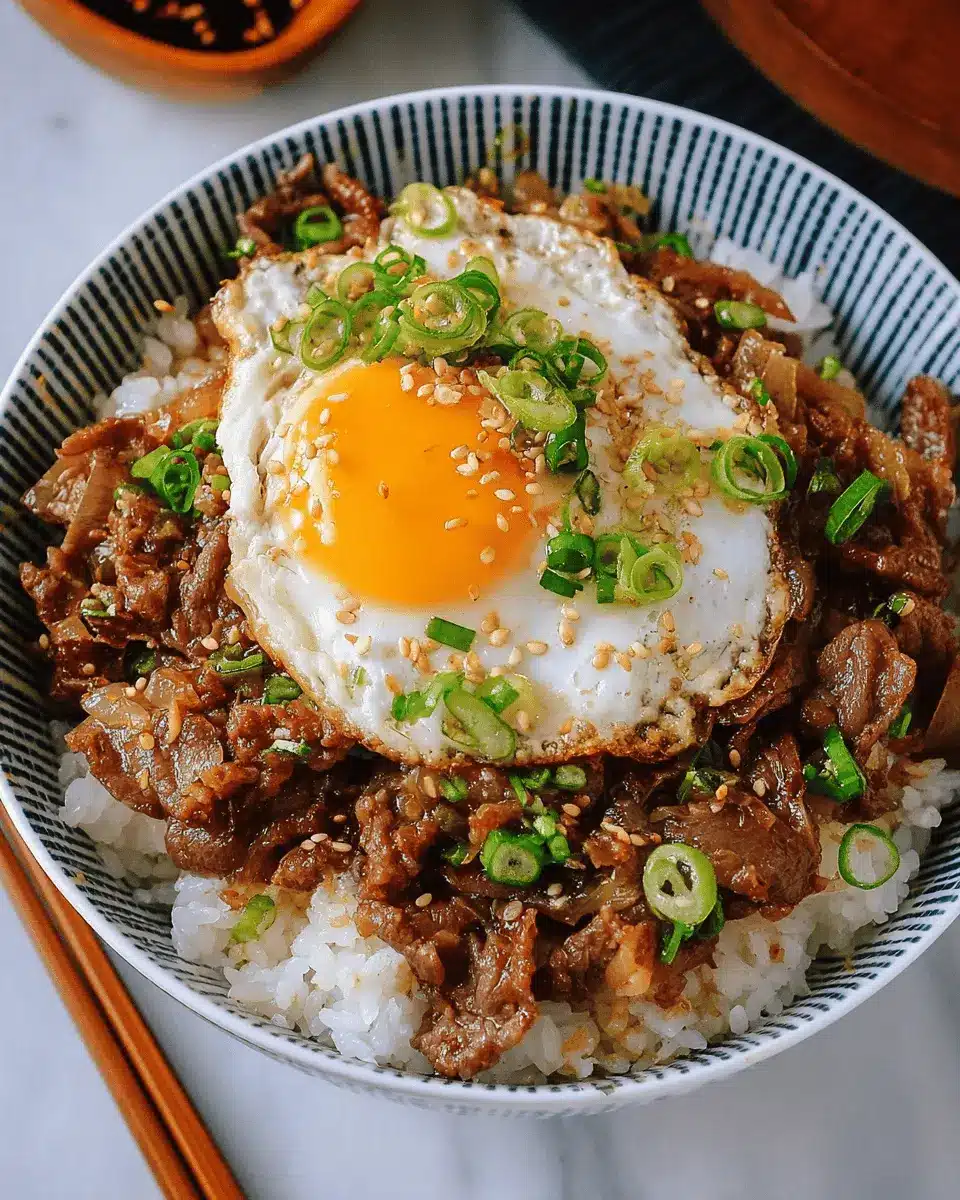
Ingredients for Gyudon (Japanese Beef & Rice Bowls)
Essential Ingredients for Gyudon
When diving into the delightful world of Gyudon, starting with the right ingredients is key. Here’s what you’ll need for a deliciously satisfying bowl:
- Neutral oil (vegetable or canola works best)
- 2 medium onions (very thinly sliced for optimal sweetness)
- 1 pound of very thinly sliced fatty beef (opt for chuck or ribeye for juiciness)
- 2 teaspoons sugar (to balance the savory flavors)
- 2 tablespoons mirin (a sweet rice wine, which is a staple in Japanese cuisine)
- 2 tablespoons soy sauce (for that umami kick)
- 1 cup dashi stock (or beef/chicken stock for depth)
- 4 eggs (sunny-side up for that creamy finish)
- 4 cups cooked white rice (short or medium grain preferred)
Optional Ingredients for Extra Flavor
Want to take your Gyudon Japanese Beef Rice Bowls to the next level? Consider adding these flavorful extras:
- 1 scallion, chopped (for a fresh, crisp bite)
- 2 teaspoons toasted sesame seeds (optional, but these add a delightful crunch)
Feel free to explore these additions, which not only enhance the taste but also elevate the visual appeal of your dish. For a deep dive into Japanese cooking techniques, check out Japanese Cooking 101. Now, get ready to indulge in a warm, comforting bowl of Gyudon!
Preparing Gyudon Japanese Beef Rice Bowls
Making Gyudon Japanese Beef Rice Bowls is a delightful experience that combines simple techniques with a melange of flavors. This dish is beloved for its heartiness and ease of preparation, making it a perfect weeknight dinner. Let’s dive into the steps of creating this comforting meal!
Gather and Prepare Ingredients
Before you dive into cooking, it’s essential to get everything organized. This makes the cooking process smoother and more enjoyable.
- Gather the following ingredients:
- Neutral oil (like vegetable or canola)
- 2 medium onions, thinly sliced
- 1 pound of thinly sliced beef (fatty beef chuck or ribeye works perfectly)
- 2 teaspoons sugar
- 2 tablespoons of mirin
- 2 tablespoons of soy sauce
- 1 cup of dashi stock (can substitute with beef or chicken stock)
- 4 eggs
- 4 cups of cooked white rice (short or medium grain is best)
- 1 scallion, chopped for garnish
- Toasted sesame seeds, if desired
With everything ready, you can flow through each step without scrambling for ingredients.
Sauté the Onions
The first step in building flavor is sautéing those onions!
- Heat a tablespoon of neutral oil in a large skillet over medium-high heat.
- Add your thinly sliced onions and cook them for about 10 minutes until they’re soft and slightly caramelized. Stir often to avoid burning. This step releases a delightful sweetness that will enhance your Gyudon Japanese Beef Rice Bowls.
Cook the Beef
Now that your onions are ready, it's time to cook the star of the show: the beef.
- Add the sliced beef to the skillet along with the sugar. Sauté until the beef is slightly browned, which should take about 3-5 minutes.
- Next, pour in the mirin, soy sauce, and dashi stock. Bring everything to a gentle simmer and cook for an additional 10-15 minutes. This will allow the sauce to reduce into a savory glaze that clings to the beef.
Simmer with Soy Sauce and Mirin
During the simmering, the flavors meld beautifully, creating a savory-sweet balance that's characteristic of traditional Gyudon.
- Keep an eye on the mixture; adjust the seasoning by adding a bit more soy sauce if desired. This step is crucial as it can help in tailoring the flavor to suit your personal preference.
Cook the Eggs
While the beef simmers, let’s multitask!
- Heat a non-stick skillet with a couple of tablespoons of oil and crack the eggs in there, cooking them sunny-side up. Aim for runny yolks for that authentic touch! If your skillet is small, you might want to do this in batches.
Assemble Your Bowl
Finally, it’s time for the best part—putting everything together!
- Divide the cooked rice among serving bowls.
- Top each bowl with the flavorful beef mixture and a sunny-side up egg.
- Toss on a sprinkle of chopped scallion and toasted sesame seeds for that extra flair.
Serve immediately and enjoy your delicious Gyudon Japanese Beef Rice Bowls. This dish is not just about feeding the stomach; it’s about nourishing your soul with flavors that resonate warmth and comfort. Happy cooking!

Variations of Gyudon
Gyudon with Different Proteins
Although gyudon traditionally features beef, you can easily experiment with various proteins to create your own flavorful twist. Consider swapping beef with chicken, turkey bacon, or even tofu for a delightful change. The cooking process remains similar; just adjust the seasoning to suit the protein of your choice. For instance, chicken tends to soak up flavors beautifully, lending itself well to the sweet-savory sauce. If you're a seafood lover, try using shrimp or salmon for a unique take.
Vegetarian Gyudon Alternatives
If you're looking to embrace a meat-free lifestyle, vegetarian gyudon alternatives can be both delicious and satisfying. Opt for marinated tofu or seitan, which mimics beef’s texture quite well. You can also use mushrooms like shiitake or portobello to add umami depth to your dish. Pair them with a rich dashi stock made from seaweed to enhance the flavor further. For a fresh crunch, serve your vegetarian gyudon with a sprinkle of chopped green onions and sesame seeds. You might find a newfound appreciation for this beloved Japanese dish!
These variations not only cater to different dietary preferences but also provide an exciting way to savor the traditional flavors of gyudon, making each meal a delightful experience.
Cooking Tips and Notes for Gyudon
Tips for Slicing Beef Thinly
To achieve the perfect Gyudon Japanese Beef Rice Bowls, it’s crucial to slice your beef thinly for that tender, melt-in-your-mouth texture. Here’s a quick tip: freeze the beef for about 30 minutes before slicing. This firms it up, making it easier to cut thin slices against the grain. Using a sharp knife speeds things up too; a dull knife can squash the meat instead of slicing it cleanly.
Secrets to Perfectly Cooked Eggs
For those rich, runny eggs that elevate your Gyudon, cook them on low heat in a non-stick skillet. Gently crack the eggs and let them sit until the whites are just set while keeping the yolks delightfully soft. Those golden yolks will break over your beef and rice, creating a mouthwatering blend that’s hard to resist! Happy cooking!
For more tips on egg cooking techniques, check out Serious Eats.
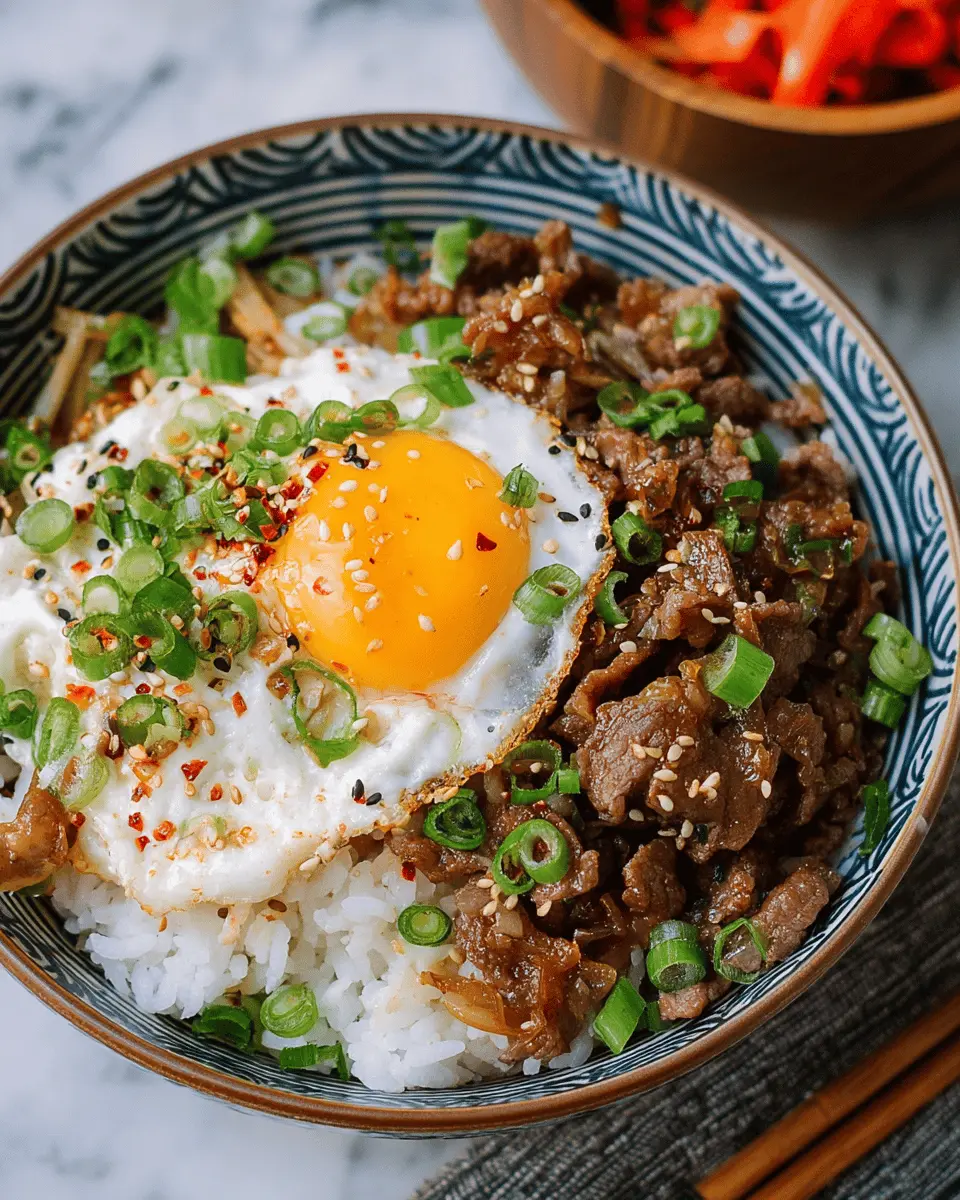
Serving Suggestions for Gyudon
Traditional Garnishes
To elevate your Gyudon Japanese Beef Rice Bowls, consider adding traditional garnishes. A sprinkle of finely chopped scallions adds a fresh crunch, while toasted sesame seeds provide a nuttiness that enhances the dish's flavor. For a little zing, adding a few slivers of pickled ginger can also brighten up each bite and bring out the umami of the beef.
Ideal Side Dishes
Pair your gyudon with some complementary side dishes for a complete meal. Miso soup is a classic choice, bringing warmth and depth. You could also serve a fresh and crisp cucumber salad, lightly seasoned with soy sauce and rice vinegar, for a refreshing contrast. For dessert, consider enjoying some mochi to round out your Japanese dining experience.
These suggestions can transform your gyudon into a restaurant-quality meal, perfect for impressing friends or treating yourself!
Time Breakdown for Gyudon
Preparation Time
Getting everything ready takes about 10 minutes. You’ll want to thinly slice your onions and beef to ensure they cook evenly and absorb all those delicious flavors.
Cooking Time
The magic happens in the kitchen for 30 minutes. This includes sautéing the onions, simmering the beef in a savory sauce, and frying up those perfect sunny-side-up eggs.
Total Time
In just 40 minutes, you’ll have a fantastic meal of Gyudon, Japanese Beef and Rice Bowls, prepared to wow your taste buds! Perfect for a quick weeknight dinner or impressing friends with your culinary skills.
Nutritional Facts for Gyudon
Caloric Content
One serving of Gyudon, or Japanese Beef Rice Bowls, contains approximately 598 calories. This makes it a satisfying meal, perfect for lunch or dinner without compromising on flavor.
Macronutrient Breakdown
In each serving, you'll find a balanced macronutrient profile:
- Carbohydrates: 57g
- Protein: 36g
- Fat: 25g (with 12g of saturated fat)
Rich in protein and supported by healthy carbs from the rice, Gyudon offers a well-rounded meal to keep you energized throughout your busy day. For more detailed nutritional insights, check out this Nutritional Guide.
Did you know that incorporating lean beef increases iron intake, crucial for maintaining energy levels? It's fantastic when you're tackling a hectic work schedule! Enjoy your Gyudon guilt-free, knowing it's as nourishing as it is delicious!
FAQs about Gyudon Japanese Beef Rice Bowls
Can I make Gyudon in advance?
Absolutely! Gyudon Japanese Beef Rice Bowls can be made ahead of time. Prepare the beef and onion mixture and store it in an airtight container in the refrigerator for up to 3 days. When you're ready to enjoy, simply reheat it in a pan while preparing fresh rice, and serve with a sunny-side-up egg on top.
What can I substitute for dashi stock?
If you don't have dashi stock on hand, don’t worry! You can substitute it with beef or chicken stock for a savory flavor. Alternatively, vegetable stock is an option, though it may not capture the authentic taste of traditional Gyudon. For a more authentic touch, consider making your own dashi using kombu (dried kelp) and bonito flakes, which you can find in Asian grocery stores.
How do I customize my Gyudon?
Customization is one of the best parts of making Gyudon! You can add your favorite vegetables like shiitake mushrooms or bell peppers for extra flavor and nutrition. For a spicy kick, drizzle some sriracha or add thinly sliced green chilis. Experiment with different toppings too—try adding pickled ginger or a sprinkle of nori for a unique twist on this classic dish.
Conclusion on Gyudon
In reflecting on Gyudon, the Japanese beef rice bowl, it's clear why this dish is a beloved staple. The balance of tender beef, sweet mirin, and savory soy sauce creates a comforting flavor profile. Perfect for any weeknight meal, Gyudon gives you a taste of Japan right at home!

Gyudon (Japanese Beef & Rice Bowls)
Equipment
- skillet
- Cast iron skillet or non-stick skillet
Ingredients
- 2 tablespoons Neutral oil such as vegetable or canola
- 2 medium Onions very thinly sliced
- 1 pound Thinly sliced beef fatty beef chuck or ribeye
- 2 teaspoons Sugar
- 2 tablespoons Mirin
- 2 tablespoons Soy sauce
- 1 cup Dashi stock can substitute beef or chicken stock
- 4 units Eggs
- 4 cups Cooked white rice short grain or medium grain preferred
- 1 unit Scallion chopped
- 2 teaspoons Toasted sesame seeds optional
Instructions
- Heat the neutral oil in a large skillet over medium high heat, and cook the sliced onions for about 10 minutes, stirring often.
- Add the beef and sugar, and cook until the beef is slightly browned. Add the mirin, soy sauce, and stock. Bring to a simmer, and cook for about 10-15 minutes to reduce the stock into a thin sauce. Taste for seasoning, and add a little more soy sauce if needed.
- Meanwhile, heat another couple tablespoons of oil in a cast iron or non-stick skillet. Cook the eggs sunny-side up. You can cook them in batches if needed. The yolks should still be runny!
- When the beef is done simmering, divide the rice among serving bowls, and top with the beef and an egg for each bowl. Garnish with chopped scallion and toasted sesame seeds, if using.


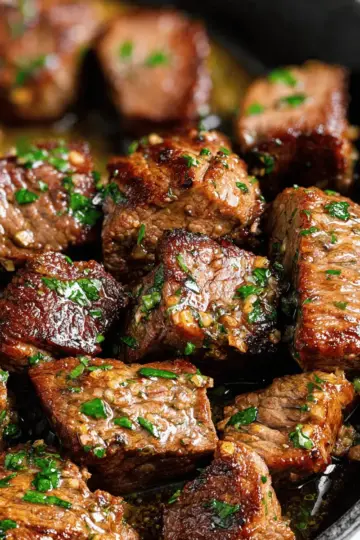
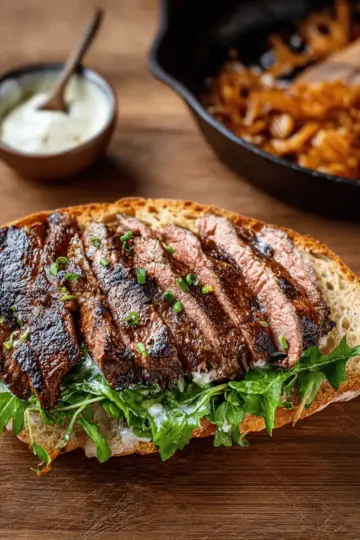
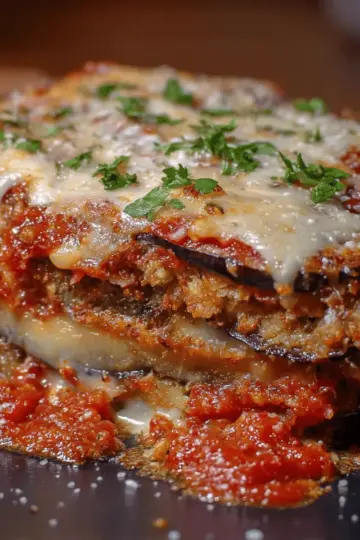
Leave a Reply